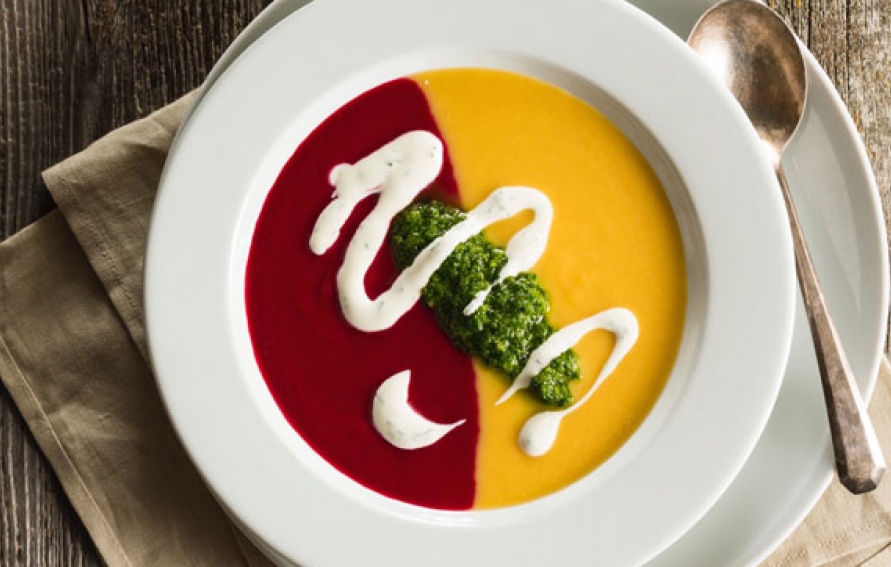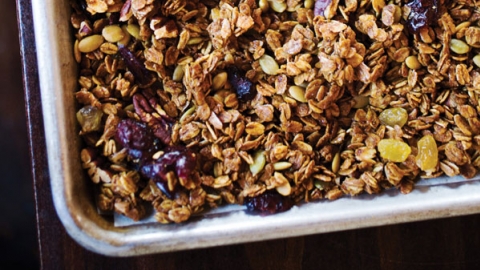About this recipe
From Heartland: Farm-Forward Dishes from the Great Midwest (Burgess Lea Press 2015)
by Lenny Russo
Used by Permission
The Twin Cities are home to a sizable Ukrainian community. Their devotion to family and to the preservation of their language and culture has always held a special attraction. On Hennepin Avenue in the northeast Minneapolis neighborhood where they first settled, there’s a famous Eastern European deli and restaurant called Kramarczuk’s, founded by war refugees in 1954. It remains a mecca for sausage lovers to this day, and was a James Beard Award America’s Classic honoree in 2013.
I was introduced to Ukrainian borscht 20 years ago in a church kitchen. It was a rustic stew with chunks of beets, cabbage and beef floating in delectable broth topped with sour cream. This version was inspired by those humble origins. I simply refined it for those who tend not to dine at church suppers. (They don’t know what they’re missing!) Of course you can make this with beets of just one color, but it’s fun to pull out all the stops and prepare the whole trio.
Instructions
Serves 6
For the red borscht:
¼ cup grapeseed oil
¼ cup peeled and diced carrots
¼ cup diced onions
¼ cup diced celery
2 small garlic cloves, peeled and crushed
1 shallot, peeled and sliced
1 pound red beets, roasted, peeled and diced
¼ cup dry red wine
1 cup Chicken Stock (page TK)
1 tablespoon chopped Italian parsley
1 teaspoon fine sea salt
1/2 teaspoon freshly ground white pepper
1 cup Dill Crème Fraiche
To prepare the red borscht, heat the oil in a large nonreactive pot over moderately low heat. Add the carrots, onions, celery, garlic and shallot and sweat until tender, about 5 minutes. Add the beets, wine and stock. Increase the heat and simmer, covered, for 30 minutes. Transfer to a blender, working in batches if necessary, and purée until smooth. Season with the salt and pepper.
Gold Borscht
For the gold borscht, follow the instructions for red borscht in the same quantities, substituting gold beets for the red, white wine for the red wine and 1/2 teaspoon freshly ground nutmeg for the parsley.
To serve, reheat the red and gold borschts in separate pans if necessary. The green borscht is served uncooked. It’s important that you work with confidence when plating the tricolor borscht. Using two 4-ounce ladles, simultaneously pour 1 ladle of red borscht and 1 ladle of gold borscht into opposite sides of the same heated shallow soup dish. This takes a little practice, but don’t be intimidated. If done correctly, the bowl will have roughly two equal sides of red and gold borscht. Swirl 1 ounce of the green borscht over the top, then swirl in the crème fraîche. Serve immediately.
Green Borscht
This light, nourishing uncooked soup tastes great on its own or as part of the showier tricolor borscht presentation. The recipe can be easily adapted for vegetarians by substituting Court-Bouillon or vegetable stock for the chicken stock. It also makes a fine vegan meal without the crème fraîche. If you can’t find the springtime perennial herb sorrel, subsitute more spinach.
Makes about 3 cups
½ pound sorrel, stemmed
½ pound spinach, stemmed
½ cup diced onions
1 small sweet onion, peeled and chopped
4 ounces basil leaves, stemmed
1 tablespoon freshly squeezed lemon juice
½ cup cold Court-Bouillon (page TK) or vegetable stock
1 teaspoon fine sea salt
½ teaspoon freshly ground white pepper
In a food processor, combine the sorrel, spinach, onions, basil, lemon juice, court-bouillon, salt and pepper. Pulse to a fine purée; a slightly coarse texture is also good. Refrigerate until needed.
Dill Crème Fraîche
1 cup crème fraîche
2 tablespoons chopped fresh dill
1 teaspoon sea salt
1/2 teaspoon freshly ground black pepper
In a stainless steel bowl, combine the crème fraîche, dill, salt and pepper. Stir with a spoon to mix well, cover and refrigerate until ready to use.






